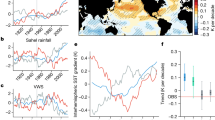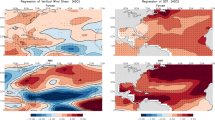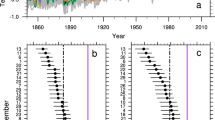Abstract
North Atlantic hurricane activity has increased substantially since the 1970s (refs 1, 2), but whether this is attributable to natural internal variability1,3 or external forcing4,5,6,7 has not been resolved8. Either way, hurricane frequency is potentially predictable, because climate models can directly simulate year-to-year variations in Atlantic tropical storm frequency, if forced by observed sea surface temperatures9. However, skilful predictions have been limited to lead times of one season10, and evidence for external forcing of hurricane frequency has been indirect, relying on statistical relationships4 or external influences on related environmental factors5,6,7. Here we extend skilful climate model predictions of hurricane frequency to lead times of several years, using decadal predictions11 with nine variants of a general circulation model. In our experiments, the recent increase in tropical storm numbers was not caused by internal variability alone. This provides physically based model evidence of externally forced changes in hurricane frequency, albeit from a single modelling system. Initialization of the model with the observed state of the climate improves forecast skill, mainly through better predictions of tropical Pacific and North Atlantic ocean conditions, in line with previously documented teleconnections1,3,12,13,14,15. Our results show that predictions of hurricane frequency are viable beyond the seasonal scale, and further elucidate causes of hurricane variability.
This is a preview of subscription content, access via your institution
Access options
Subscribe to this journal
Receive 12 print issues and online access
$259.00 per year
only $21.58 per issue
Buy this article
- Purchase on Springer Link
- Instant access to full article PDF
Prices may be subject to local taxes which are calculated during checkout




Similar content being viewed by others
References
Goldenberg, S. B., Landsea, C. W., Mestas-Nunez, A. M. & Gray, W. M. The recent increase in Atlantic hurricane activity: Causes and implications. Science 293, 474–479 (2001).
Klotzbach, P. J. & Gray, W. M. Multidecadal variability in North Atlantic tropical cyclone activity. J. Clim. 21, 3929–3935 (2008).
Zhang, R. & Delwoth, T. L. Impact of Atlantic multidecadal oscillations on India/Sahel rainfall and Atlantic hurricanes. Geophys. Res. Lett. 33, L17712 (2006).
Mann, M. E. & Emanuel, K. A. Atlantic hurricane trends linked to climate change. Eos, Trans. Am. Geophys. Union 87, 233–244 (2006).
Trenberth, K. E. & Shea, D. J. Atlantic hurricanes and natural variability in 2005. Geophys. Res. Lett. 33, L12704 (2006).
Holland, G. J. & Webster, P. J. Heightened tropical cyclone activity in the North Atlantic: Natural variability or climate trend? Philos. Trans. R. Soc. Lond. 365, 2695–2716 (2007).
Gillett, N. P., Stott, P. A. & Santer, B. D. Attribution of cyclogenesis region sea surface temperature change to anthropogenic influence. Geophys. Res. Lett. 35, L09707 (2008).
Knutson, T. R. et al. Tropical cyclones and climate change. Nature Geosci. 3, 157–163 (2010).
Zhao, M., Held, I. M., Lin, S-J. & Vecchi, G. A. Simulations of global hurricane climatology, interannual variability, and response to global warming using a 50 km resolution GCM. J. Clim. 22, 6653–6678 (2009).
Vitart, F. et al. Dynamically-based seasonal forecasts of Atlantic tropical storm activity issued in June by EUROSIP. Geophys. Res. Lett. 34, L16815 (2007).
Smith, D. M. et al. Improved surface temperature prediction for the coming decade from a global climate model. Science 317, 796–799 (2007).
Knight, J. R., Folland, C. K. & Scaife, A. A. Climate impacts of the Atlantic Multidecadal Oscillation. Geophys. Res. Lett. 33, L17706 (2006).
Goldenberg, S. B. & Shapiro, L. J. Physical mechanisms for the association of El Nino and West African rainfall with Atlantic major hurricane activity. J. Clim. 9, 1169–1187 (1996).
Tang, B. H. & Neelin, J. D. ENSO influence on Atlantic hurricanes via tropospheric warming. Geophys. Res. Lett. 31, L24204 (2004).
Vimont, D. J. & Kossin, P. The Atlantic meridional mode and hurricane activity. Geophys. Res. Lett. 34, L07709 (2007).
Landsea, C. W. Counting Atlantic tropical cyclones back to 1900. Eos, Trans. Am. Geophys. Union 88, 197–208 (2007).
Pielke, R. A. et al. Normalized hurricane damage in the United States: 1900–2005. Nat. Hazards Rev. 9, 29–42 (2008).
Bender, M. A. et al. Modeled impact of anthropogenic warming on the frequency of intense Atlantic hurricanes. Science 327, 454–458 (2010).
LaRow, T. E., Lim, Y-K., Shin, D. W., Chassignet, E. P. & Cocke, S. Atlantic basin seasonal hurricane simulations. J. Clim. 21, 3191–3206 (2008).
Keenlyside, N. S., Latif, M., Jungclaus, J., Kornblueh, L. & Roeckner, E. Advancing decadal-scale climate prediction in the North Atlantic sector. Nature 453, 84–88 (2008).
Pohlmann, H., Jungclaus, J., Köhl, A., Stammer, D. & Marotzke, J. Initializing decadal climate predictions with the GECCO oceanic synthesis: Effects on the North Atlantic. J. Clim. 22, 3926–3938 (2009).
Mochizuki, T. et al. Pacific decadal oscillation hindcasts relevant to near-term climate prediction. Proc. Natl Acad. Sci. USA 107, 1833–1837 (2009).
Saunders, M. A. & Lea, A. S. Large contribution of sea surface warming to recent increase in Atlantic hurricane activity. Nature 451, 557–561 (2008).
Landsea, C. W., Vecchi, G. A., Bengtsson, L. & Knutson, T. R. Impact of duration threshold on Atlantic tropical cyclone counts. J. Clim. 23, 2508–2519 (2010).
Emanuel, K. Environmental factors affecting tropical cyclone power dissipation. J. Clim. 20, 5497–5509 (2007).
Latif, M., Keenlyside, N. & Bader, J. Tropical sea surface temperature, vertical wind shear, and hurricane development. Geophys. Res. Lett. 34, L01710 (2007).
Garner, S. T., Held, I. M., Knutson, T. & Sirutis, J. The roles of wind shear and thermal stratification in past and projected changes of Atlantic tropical cyclone activity. J. Clim. 22, 4723–4734 (2009).
Kang, S. M., Held, I. M., Frierson, D. M. W. & Zhao, M. The response of the ITCZ to extratropical thermal forcing: Idealized slab-ocean experiments with a GCM. J. Clim. 21, 3521–3532 (2008).
Mantsis, D. F. & Clement, A. C. Simulated variability in the mean atmospheric meridional circulation over the 20th century. Geophys. Res. Lett. 36, L06704 (2009).
Brohan, P., Kennedy, J., Harris, I., Tett, S. F. B. & Jones, P. D. Uncertainty estimates in regional and global observed temperature changes: A new dataset from 1850. J. Geophys. Res. 111, D12106 (2006).
Acknowledgements
We thank many colleagues in the Met Office for developing the climate models, and for help and advice during the course of this work. Thanks also to M. McVean at ECMWF for carrying out the hindcasts. We are grateful to M. Bender for comments that improved this paper. This work was supported by the Joint DECC and Defra Integrated Climate Programme—DECC/Defra (GA01101)UK, and by the EU FP6 ENSEMBLES project.
Author information
Authors and Affiliations
Contributions
D.M.S. led the analysis and interpretation. D.F. developed the storm tracking algorithm, which R.E. used to analyse storm counts. D.M.S., R.E., H.P. and N.J.D. conducted the analysis. D.M.S. and J.M.M. developed DePreSys and designed the experiments. D.M.S. and A.A.S. wrote the paper with contributions from all authors.
Corresponding author
Ethics declarations
Competing interests
The authors declare no competing financial interests.
Supplementary information
Supplementary Information
Supplementary Information (PDF 349 kb)
Rights and permissions
About this article
Cite this article
Smith, D., Eade, R., Dunstone, N. et al. Skilful multi-year predictions of Atlantic hurricane frequency. Nature Geosci 3, 846–849 (2010). https://doi.org/10.1038/ngeo1004
Received:
Accepted:
Published:
Issue Date:
DOI: https://doi.org/10.1038/ngeo1004
This article is cited by
-
The effect of initialisation on 20 year multi-decadal climate predictions
Climate Dynamics (2024)
-
Tropical Atlantic multidecadal variability is dominated by external forcing
Nature (2023)
-
Tropical Biogeomorphic Seagrass Landscapes for Coastal Protection: Persistence and Wave Attenuation During Major Storms Events
Ecosystems (2021)
-
Identifying a human signal in the North Atlantic warming hole
Nature Communications (2020)
-
A Possible Approach for Decadal Prediction of the PDO
Journal of Meteorological Research (2020)



